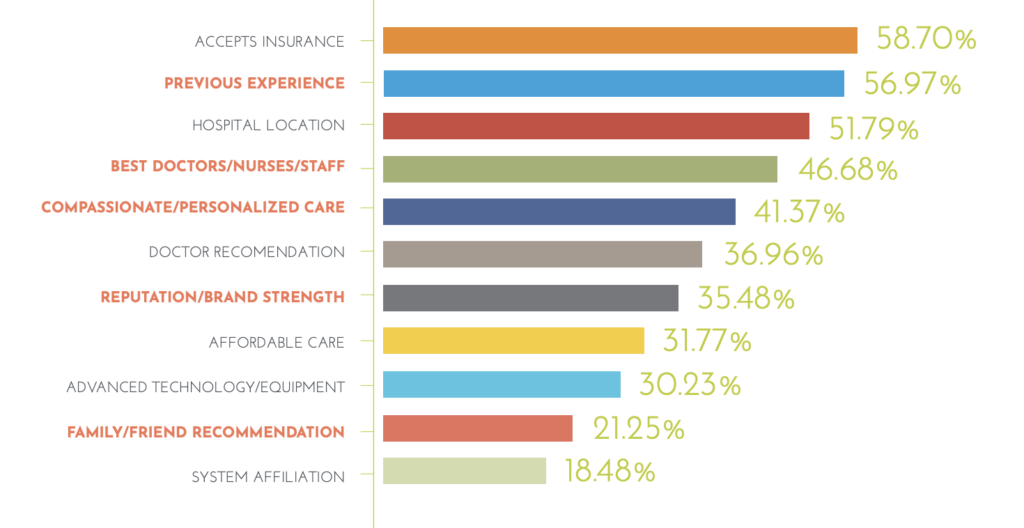
9 Steps Providers Can Take To Influence Patient Loyalty
Home » 9 Steps Providers Can Take To Influence Patient Loyalty
9 Steps Providers Can Take To Influence Patient Loyalty
Home » 9 Steps Providers Can Take To Influence Patient Loyalty

Home » 9 Steps Providers Can Take To Influence Patient Loyalty
Home » 9 Steps Providers Can Take To Influence Patient Loyalty

Online reviews and other vehicles of comparison have quickly become the new norm across healthcare, as they have long been in other industries.
Rising out-of-pocket costs for healthcare have converted patients into more careful, and warier, consumers: they’re approaching healthcare services with greater cost-consciousness; consulting consumer information sites intended to help them make more informed choices; and paying much closer attention to health system mentions on social media and other informal registers of patient experience.
Currently, patient satisfaction is treated as one proxy for the quality of care a patient receives. While satisfaction scores undoubtedly help gauge the experience of a single episode of care, they ultimately fall short of a larger, more important goal: to get patients to see the health system and its providers in a spirit of long-term partnership and collaboration.
In other words, instead of focusing on episodic patient satisfaction, the way to create real value in today’s industry is to earn patients’ loyalty – in which providers play a key role.
According to healthcare expert Nicholas Webb, health systems are now joining the “89 percent of companies that expect to compete mostly on the basis of customer experience.”
Another expert, Joseph Fifer, President and CEO of the Healthcare Financial Management Association, says our industry is quickly becoming something he refers to as “an experience economy.”
The new-to-healthcare concept of “experience economy” provides a useful framework for thinking about patient loyalty. This framework explains consumer choices not as cold, objective calculations but rather as decision-making processes involving emotion, memory, and trust. And while Fifer is referring mainly to patients’ financial experience in a healthcare setting, providers should remember that patient experiences affect their trust and their engagement which in turn impact health outcomes.
As this chart shows, some of the patient loyalty drivers can only be tackled at the administrative level. However, five of the top 11 drivers are directly related to patient experience.

These are more subjective (i.e., different people might define “best,” “compassionate,” and “personalized” differently) – and that means they may be influenced more readily.
As a provider, you have the opportunity to make an impact on hospital performance and patient experience through not only high-quality clinical care but also by focusing on the patient and their family’s overall experience. Here are 9 tips you can follow to help improve the patient experience and drive patient loyalty in your hospital.
A patient’s experience is tied to their expectations, which may, at times, be unreasonable. Nonetheless, your awareness of the patient’s expectations during consultations is vital to achieving effective communication.
When the quality of provider communication is rated highly, patients are more likely to be satisfied with the quality of care they receive.
Tip: If a patient has had a previous experience in the hospital, they should know that you’re aware. Simply acknowledging this fact can help you avoid one of the highest sources of frustration for returning customers (and patients): Being treated as if you’ve never been there before.
This isn’t new advice, but it bears repeating. Look into the patient’s eyes and listen intently and actively. Ask open-ended questions to draw out more information.
With the high levels of activity occurring throughout the hospital, taking the time (even though you may not have a lot of it) to stop, look, and listen is priceless. It shows empathy and respect, and demonstrates that you value the patient as a human being.
Tip: When you establish sincere eye contact, the patient perceives you have spent more time with them than you actually have. Studies also show that sitting down, even for a brief period, also improves the perception of time spent caring for the patient.
Effective communication accompanied by compassionate care fosters a healthy provider-patient relationship and engenders trust that can lead to better outcomes, both physiologically and psychologically.
To paraphrase an old adage, "Patients don’t care how much you know until they know how much you care."
Since, as a provider, you are limited in the time available to spend with each patient, following these techniques during treatment can help insure quality interactions with your patient and their family.
"Information delivery is a strong determinant of patient satisfaction,” says Kenneth J. Heinrich, MD FACEP and SVP, Group Medical Officer at SCP. “The lack of information magnifies a patient’s sense of uncertainty and increases their psychological distress.”
Be sure to communicate:
"Information delivery is a strong determinant of patient satisfaction,” says Kenneth J. Heinrich, MD FACEP and SVP, Group Medical Officer at SCP. “The lack of information magnifies a patient’s sense of uncertainty and increases their psychological distress.”
Be sure to communicate:
Another way to facilitate effective communication is to simplify the terminology you use. That’s not always easy but speaking in plain English at a level patients can understand can have positive benefits.
“Take time with the patient, be courteous, and express genuine concern,” says Dr. Heinrich. “Patients are poor judges of the technical aspects of care and, therefore, more affected by the expressive (caring) aspect of treatment than the technical (curing). They desire ‘high touch’ over ‘high tech.’”
Patients who better understand their conditions and your recommendations are more likely to take a greater interest in their care. They will ask questions, follow recommendations, and feel less intimidated, making for a better overall experience.
For example, instead of saying “cellulitis,” use the term “skin infection.” Or, in place of “PO” just say “by mouth.” Your patients will appreciate your effort to meet them where they are linguistically.
Tip: If you need help translating doctor-speak into language anyone can understand, check out our “cheat sheet” containing some of the more common terms providers should use when seeing patients.
One reason you may need these tools to communicate is that, with growing diversities in population, it’s likely that not all of your patients will speak English.
Translation apps such as Canopy Speak or MediBabble Translator communicate quickly with patients using translated medical phrases in a variety of languages, including Spanish, Chinese, French, Arabic, Russian, Haitian Creole, and many others.
Other apps, like VisualDX, contain thousands of images that you can use to help a patient better understand his or her condition.
Recognize that symptoms are subjective.
Dr. Heinrich reminds us, “Each patient experiences pain and other symptoms in their own way. Poor symptom relief can be perceived by the patient as lack of caring.”
Take the following steps when treating symptoms:
Approximately seven percent of patients reportedly switch providers due to negative patient experiences, which translates to nearly $100 million in annual revenue loss per hospital.
This is one reason why it’s important to protect your reputation and that of your hospital from adverse public opinion resulting from negative word of mouth in order to drive patient loyalty.
When problems with customer service occur in the hospital (and they invariably will), you and your team must be prepared with a service recovery program designed to turn a displeased patient into a happy, loyal one.
A phenomenon known as the “service recovery paradox” says that when you handle your patients’ concerns or complaints quickly, they tend to be more satisfied than a patient who experienced no problems at all.
Excellence in onsite service recovery efforts starts with these 5 simple steps:
Related Resource: The Importance of Onsite Service Recovery
Having a physician call a patient the day after discharge is oftentimes unheard of today.
For that very reason, that outreach or something similar would likely feel monumental to a patient. The gap between expectation and what’s delivered feeds back into the earlier discussion of the “experience economy.” EM and HM providers stand to build immense trust, that is, by exceeding the current expectations that they are always on to the next patient and are too busy to follow up.
Commit to improving the patient experience in order to influence patient loyalty.
Hospitals charge their physicians with the same goal: to provide the best care possible for their patients at all times.
When patients affirm your health system’s values by repeatedly choosing you, you’ve contributed to a reputation – and built a relationship – you can be proud of. Any hospital that earns its patients’ loyalty stands a much better chance of experiencing financial stability. More importantly, loyalty, which stems from satisfied patients regarding the quality of care, can help to improve the patient’s life.
Please visit SCP Health’s Insurance Request Portal to submit requests related to medical malpractice liability insurance such as coverage verifications, claims history reports, and certificates of insurance. If you experience issues with the portal submission or have a question about the process, please reach out SCP Health’s Risk Management, Safety and Insurance Department at RM@scphealth.com or 337-609-1250.
By clicking the “Submit” button, you are agreeing to the SCP Heath Terms of Use and Privacy Policy
By clicking the “Submit” button, you are agreeing to the SCP Heath Terms of Use and Privacy Policy
By clicking the “Submit” button, you are agreeing to the SCP Heath Terms of Use and Privacy Policy
By clicking the “Submit” button, you are agreeing to the SCP Heath Terms of Use and Privacy Policy
By clicking the “Submit” button, you are agreeing to the SCP Heath Terms of Use and Privacy Policy
By clicking the “Submit” button, you are agreeing to the SCP Heath Terms of Use and Privacy Policy
By clicking the “Submit” button, you are agreeing to the SCP Heath Terms of Use and Privacy Policy
By clicking the “Submit” button, you are agreeing to the SCP Heath Terms of Use and Privacy Policy
By clicking the “Submit” button, you are agreeing to the SCP Heath Terms of Use and Privacy Policy
By clicking the “Submit” button, you are agreeing to the SCP Heath Terms of Use and Privacy Policy
By clicking the “Submit” button, you are agreeing to the SCP Heath Terms of Use and Privacy Policy
By clicking the “Submit” button, you are agreeing to the SCP Heath Terms of Use and Privacy Policy
Please provide your contact information. An SCP representative will contact you accordingly.